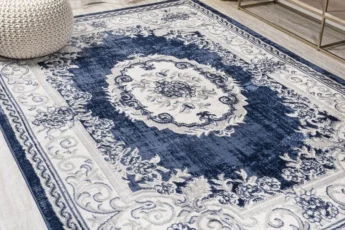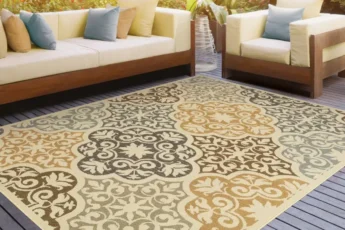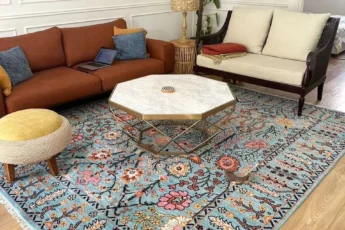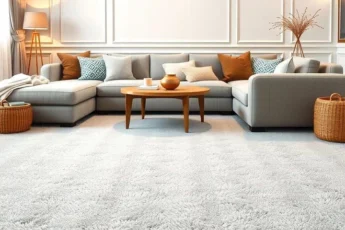Most people think of carpets as soft or warm underfoot, and leave it at that. But in luxury interiors, they’re more than that. Some are shaped around furniture, and some build contrast under walls that barely have anything hanging. This blog post by Carpets Store isn’t about what’s in stores. It’s more about what happens when a carpet becomes part of the room’s voice, not just a layer below your feet.
1. Using Carpets to Define Spaces
Sections in an open lounge can feel messy without visual boundaries. Rugs help. A large wool carpet under the seating grounds the area, instantly making it feel intentional. Overlaid on marble or tile floors, the carpet balances shine with softness.
In a gallery room, narrow stair carpets define hallway paths, echoing artwork hung above. Hard floors don’t show where one part ends and another starts. But a well-chosen carpet creates subtle rooms without tearing down walls.
2. Layering Carpets for Depth
Layering isn’t just for fashion; it works indoors, too. A simple, large carpet can get a smaller accent rug on top, creating texture and depth. For instance, a shag rug over a flat weave rug is the same palette but adds contrast.
It’s a look sometimes seen in designer homes. Overlaid carpets bring life to flat floors and better absorb sound. The result is less echo and a cozier feeling that also looks curated.
3. Choosing Premium Textures
Not all carpets feel the same. Some have that weight in them because they are dense, heavy threads that sit close to the floor, with no fuzz flying up. Others have a shine, not the plasticky kind, but a natural kind that shows in evening light.
You notice it when the room’s quiet. Hand-finished pieces aren’t flat. They have small ridges, dips, something you feel under socks. Those kinds stick around, even after the trends pass.
4. Bringing Bold Patterns to Life
Rooms that feel cold, visually, not just in temperature, sometimes just need a base that carries some story. A bold carpet helps. Doesn’t mean wild. Maybe it’s an uneven stripe, or an aged floral that looks like it’s been stepped on for years. It breaks the clean lines in a room without yelling. If the rest of the space is bare, even better. The floor becomes the only part that says something.
5. Using Unexpected Shapes
The rectangular rug standard is fine, but curves add surprise. Oval carpets work well under circular tables or inside bay window nooks. Donut-shaped pieces with center cut-outs frame a chandelier or sculptural floor piece.
A runner with tapered ends in corridors creates flow. Custom carpet shapes, such as popular choices like leaf outlines, asymmetrical edges, etc, can echo bespoke furniture lines. It’s a small change that can make a hall feel like part of the design, not just a link to the next room.
6. Color for Mood Control
Carpet colour sets the tone. Deep charcoal or navy adds drama to sitting areas. Pale grey with taupe undertones quiets bedrooms. Mixed beige and cream carpet brings warmth to sunlit living rooms.
Rich jewel tones like emerald, ruby, etc, work well in wood-panel rooms or home offices. Aim for colours that tie in with curtains, throws, or even moulding. Solid-coloured carpets aren’t boring, they’re blank canvases for all other décor.
7. Focus on Eco-Conscious Weaves
Some prefer knowing where the carpet came from. Not factory-slick, but something with fewer chemicals, more story. Wool from good stock, jute without too much bleach. Bamboo fibres too, because they feel cooler in summer rooms.
It’s not always written on tags, but once you touch it, you know it’s made differently. The smell, even. Nothing synthetic. It matters now more than it used to.
8. Integrating Underfloor Heating
Luxury homes usually install underfloor heating. Most people lay marble, but floor carpet can work too. The trick is using low‑tog carpet with dense fibres. It keeps the floor warm without blocking it. Underfloor heating isn’t only for bathrooms.
You get heated comfort in study rooms, bedrooms, and even dining areas. Pair it with a wool flat-weave carpet and the result is soft surfaces with radiant warmth.
9. Caring for Luxury Carpets
Some carpets don’t ask much. Others, you need to keep an eye on. The thicker ones? They hold dust, they hold heat. So they need air, and sometimes a deep clean. But the payoff is real. They make a space quieter, more settled. If rotated now and then, they wear better. Corners don’t curl. Colour stays close to how it looked when first laid. Takes a little effort, sure—but they give it back over time.
10. Hiring Professional Carpet Fitters
Getting a carpet to lay flat and match the floor lines isn’t easy. Edges need to be tucked well. Seams shouldn’t show. And patterns must line up across runs. Professional installers use contrasting tape or hidden seams so joints stay out of sight.
They handle transitions to other floors smartly. For shaped carpets, they trim them to millimetre accuracy. A good fitter ensures your expensive carpet wears right, functions well, and remains a beauty without lift or gaps.
Final Word
In luxury décor, carpet flooring is rarely a backup—it’s often central. When selected and installed thoughtfully, it elevates the room quietly. Detailed corners matter: the right curve carpet, a bold contrast, and textured fibres; all add richness to a space’s feel. Hard floors feel obvious; carpet hides noise, warmth, and footsteps. It’s a silent foundation. So take your time in choosing the colour, fibre, weave, and shape carefully.









